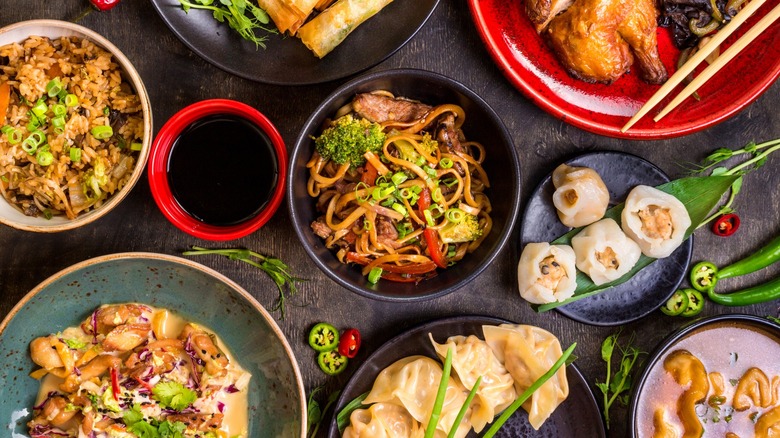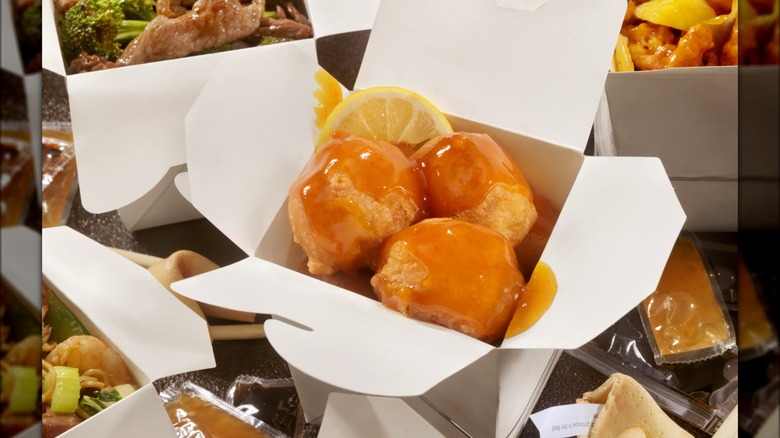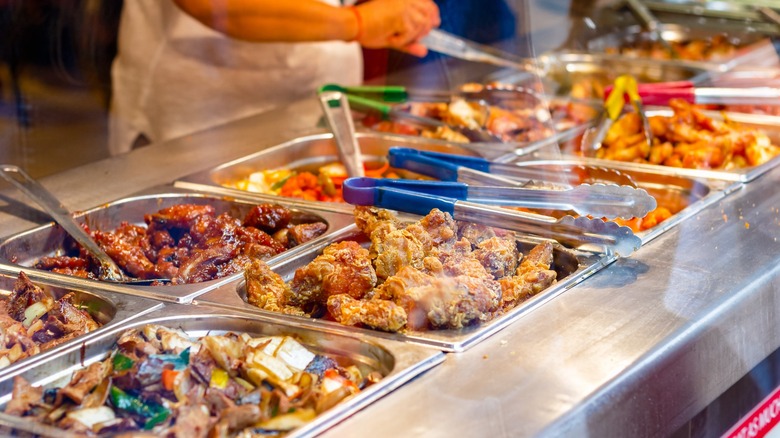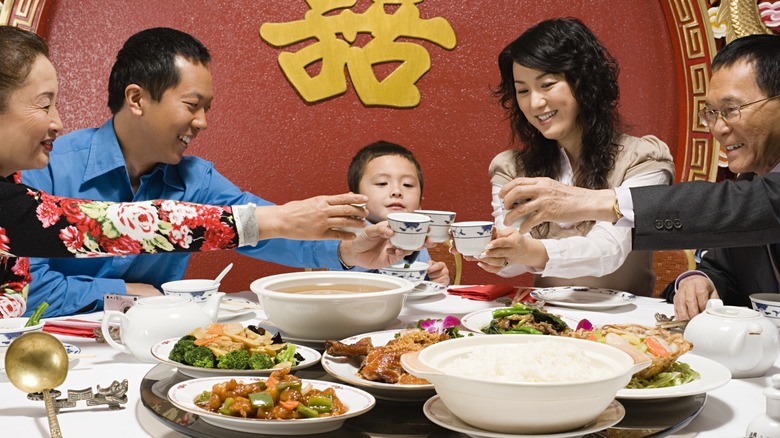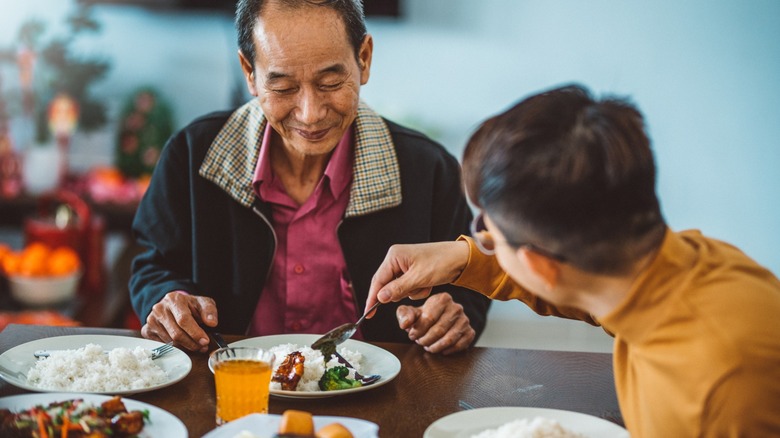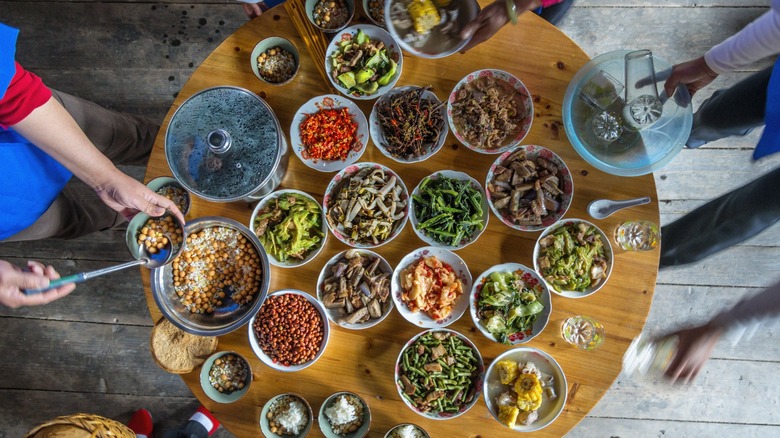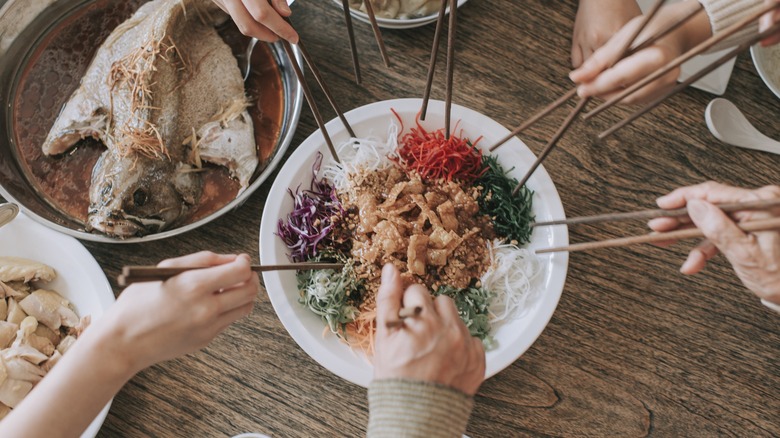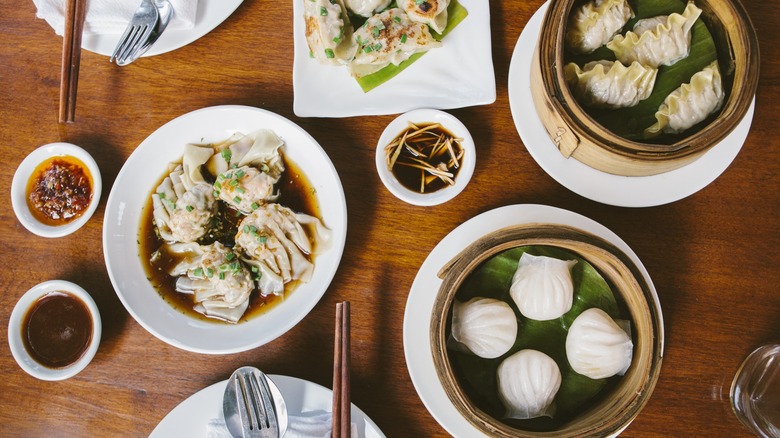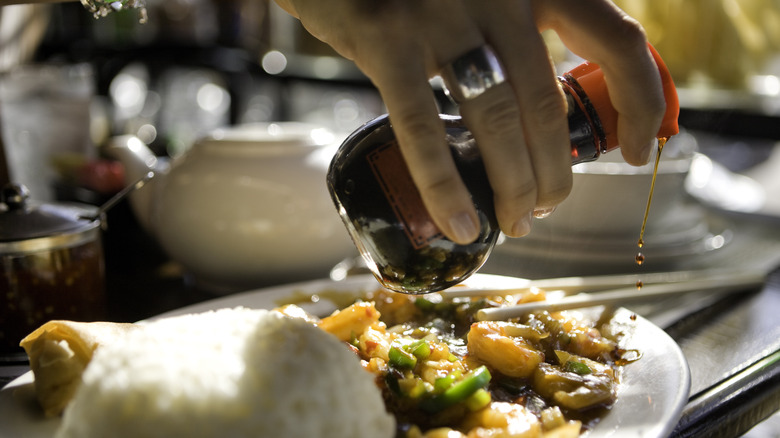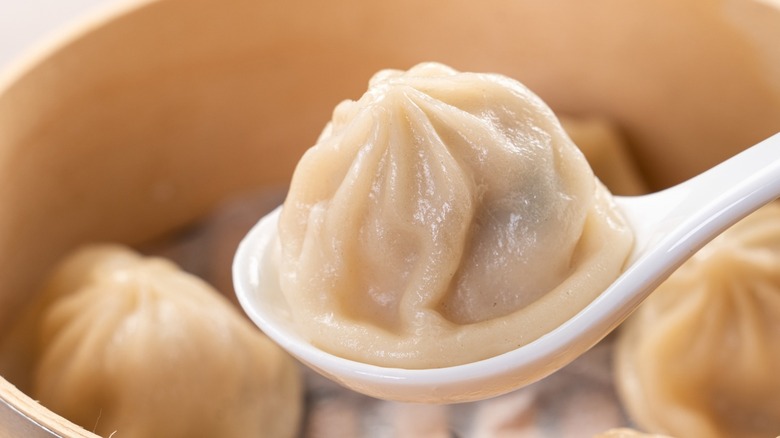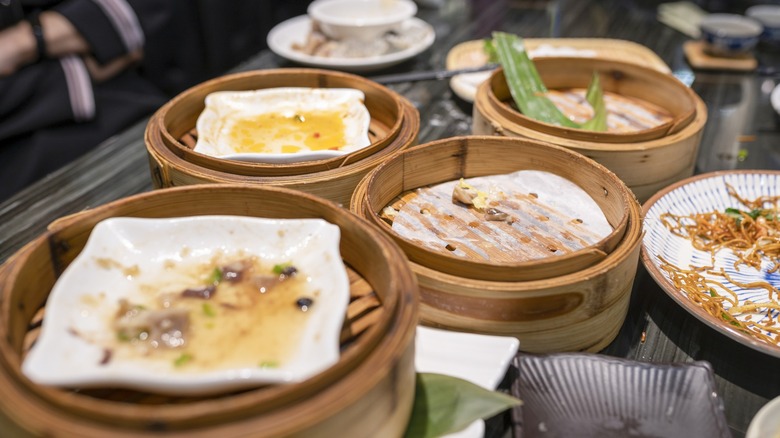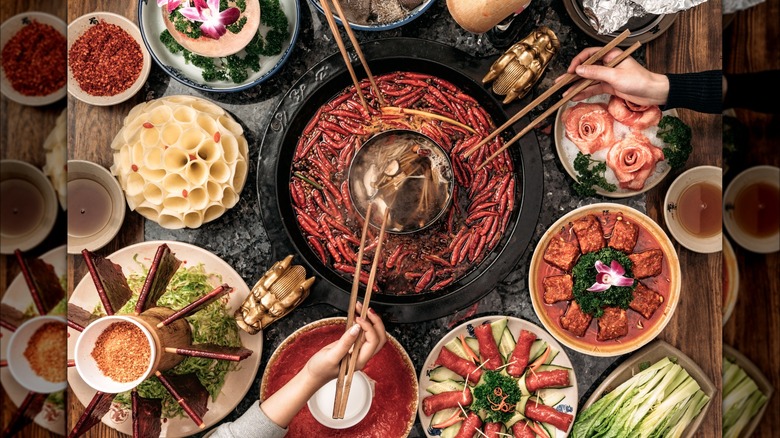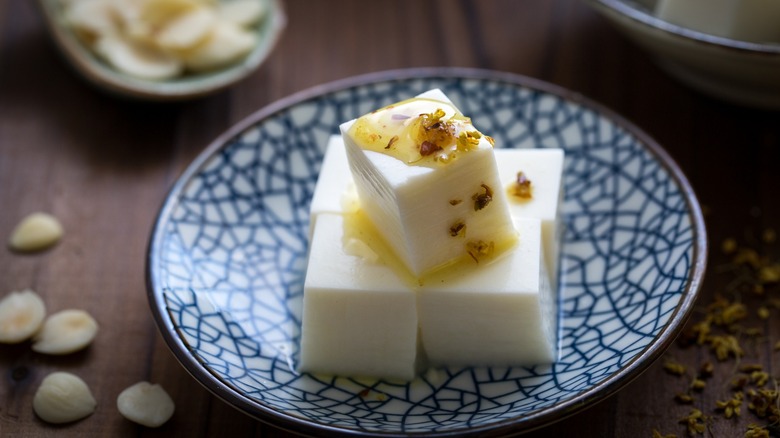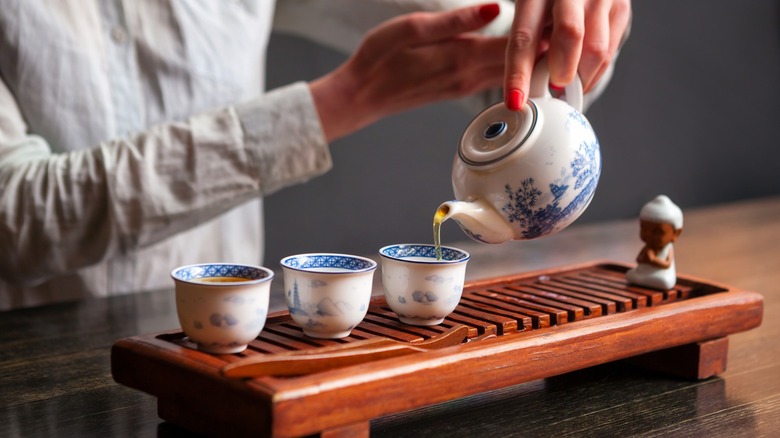13 Mistakes You're Making When Eating At A Chinese Restaurant
In North America, we love our Chinese food. From a family dinner at our favorite restaurant to a quick take-out on Friday night, we're all about the juicy egg rolls, spicy noodles, and sticky sweet chicken balls. But have you ever wondered if you're making etiquette mistakes when dining out? From simply not knowing how to handle chopsticks to the more nuanced cultural rules, it can be tricky to know what's right or wrong. For example, showing the soles of your feet (with or without shoes) can be considered quite rude. Because the sole of our foot is in contact with the ground, it's considered dirty and not looked upon with great reverence. Eating a meal with your legs crossed or, worse, with your feet on the furniture is pretty offensive.
China is a large country with an enormous population, so it would be impossible to cover all the ways you might make your host squirm, but we've outlined some of the easiest things to remember here. You'll obviously find many new and interesting rules governing etiquette within every different region, especially around mealtime. The basic tenets should remain the same, however. Chinese culture places a great deal of emphasis on respect, so if you keep that in mind and act accordingly, you should be able to enjoy your meal with ease. And no matter how much you want to impress your date with mind-blowing chopstick versions of your top-ten favorite drum solos, just don't do it.
Focusing only on Americanized Chinese food
Don't get us wrong. Obviously, Americanized Chinese food is freaking delicious, with all its deep-fried, sweet, sticky goodness. It wouldn't be as popular if it wasn't craveable and utterly fantastic. But if you truly consider yourself an authentic eater, you'd be doing yourself a disservice if you didn't take a deeper dive into all the incredible, truly Chinese dishes available.
Some of the things you've been missing out on include well-known dishes like ma po tofu or dan dan noodles, along with so many other options. You don't even need to search for a restaurant that specializes in regional cuisine (although we do recommend it, more on that later). Often, even smaller eateries will have a handful of dishes on the menu that are a better representation of true Chinese food for you to try. And when in doubt, don't be shy to ask. The staff will likely be happy to share their recommendations with you.
Believing that Chinese food is supposed to be cheap
One of the biggest misconceptions about Chinese food is that it's cheap. And sometimes it is — just like those cheap pizza slices we all know and love. But on the whole, Chinese food should be in the same price range as anything else you enjoy. And why not? If it's been made with quality ingredients by someone dedicated to the pursuit of sharing tasty food that represents their culture, then surely it deserves to be appreciated.
Historically, Chinese restaurants kept prices low in order to attract customers, even if that meant taking a hit in profit. And it worked. But unfortunately, the legacy of cheap Chinese food still lives on, even if those same restaurants aren't having as much trouble attracting eaters. The problematic and reductive view of Chinese food as cheap means that, as a consumer, you're likely missing out on terrifically well-made, fantastic food by settling for the all-you-can-eat buffet. We're not talking about spending more than you can afford; we're just saying that it might be time to acknowledge that, like other regions, Chinese food should also be priced fairly.
Ordering individual dishes for each diner
Meals are a communal activity in Asia, and in China, sharing is highly encouraged. Traditionally, many Chinese restaurants have large wooden lazy susans in the middle of larger tables, something that has gone by the wayside, especially in North America. Some dishes, like soup, are individually served to each diner, but the really tasty stuff is shared with everybody eating.
Think of it like ordering a Chinese dinner for a group of friends, where you get a taste of everything on offer. But it's more than that in Chinese culture — sharing food forces you to think about others as you're digging in. Did Grandma get a serving of the char siu? Who else hasn't tried the dumplings? Rather than just digging into your one-item plateful, you're tasting all the same things as the rest of your party. One tip for eating a communal meal with chopsticks — rather than serving yourself from the communal plate with your chopsticks, there's a simple way to deal with this (if no serving chopsticks have been provided). Simply flip those chopsticks around and pick up your serving with the clean ends.
Serving yourself first
While you're passing all those tasty dishes around the table, don't neglect this super important rule of thumb — always serve others first, especially your elders or special guests. No matter how much you want to dig into that plate of tea-smoked chicken, you can be sure that everyone else feels the same way, too. As we mentioned earlier, a big part of the communal meal is paying attention to the needs of your fellow diners, and this extends to making sure that you respect everyone at your table. Look at it this way — you can always order another dish after everyone has had a taste. And this rule extends to more than just chicken; it's just good manners to serve tea to your elders and special guests first, too.
Now that you've passed all those tasty plates around and made sure that everyone has a full plate, don't get ahead of yourself and start scarfing before everyone else. Just like elders and guests should be served first, wait until they start eating to dig in yourself.
Not realizing that China has many different regional cuisines
Without turning this into a geography lesson, it's important to realize that China is a pretty large country and one of the most populated places on Earth. Because of this, there isn't really one homogenous culture. Instead, China is made up of seven regions, each containing multiple provinces. So what does this mean for your next trip out for dinner? Well, if you're lucky, you might find yourself at a restaurant that specializes in a specific region's cuisine, such as Cantonese, Hunan, Sichuan, or Fujian.
It's true that lots of Chinese restaurants have given in to the notion of Americanization, which only makes sense from a business perspective. But if you dig a little deeper into the menu, you may find items that represent the cultural heritage of a particular region. Take a spin through those offerings to find some truly tasty treats — if you're unsure, the staff will certainly be happy to help you as they likely have a favorite item or two. The point is, remember that fried rice isn't a ubiquitous or even true representation of Chinese food. Regional Chinese food varies greatly from one area to another, each with its own styles and flavors.
Misusing chopsticks
Speaking of flipping those chopsticks around, let us give you a head's up about proper etiquette for this utensil. First, if anything you're planning on doing with them involves only half a set — just stop. Chopsticks are meant to be used in tandem, so this means no stabbing the food that you can't get a grip on (ask for a fork instead; honestly, it's ok), using one to pick your teeth, or digging around for the best bits. Not only that, it's rude to use them for anything other than eating. No tapping, drumming, pointing, or scratching (gross!), no matter how tempting it might be.
Symbolism is far more important in Asian cultures than stateside and that impacts dining etiquette. Placing your chopsticks in an X shape can mean that you have no regard for your tablemates, while sticking them upright into your dish is reminiscent of the incense sticks stuck in rice bowls at funerals, reminding your fellow diners of their demise. And those paper-wrapped chopsticks that are proffered at most restaurants? Don't even think about rubbing them together after splitting to rid them of splinters. It implies that your host is cheap, providing you with less than the best accouterments possible. If you're really worried about splinters, pack your own travel chopsticks instead, darling.
Always ordering the same thing when eating dim sum
One of the best ways to experience Chinese food is the meal known as dim sum. Often eaten during mid-day, dim sum is comprised of many little dishes. Another example of communal eating popular in China, dim sum is a terrific way to try all kinds of tasty bits without having to order an entire plateful. If you're an experienced eater, make sure you're not missing the opportunity to try something new instead of ordering all the same dishes, no matter how delicious they might be.
If you've never been before, we have everything you need to know about ordering and what to expect. It can be overwhelming if you've never been; carts full of food pass by your table, people signaling the waitstaff, the sometimes confusing system of stamps, and all the food choices. As a cart goes by, patrons take a look at what's on offer and pick dishes. The server stamps the bill and leaves the food. It's really not much more involved than that. Typically, a dim sum meal can last for a while, so make sure to order as you're ready to eat it rather than letting something get cold while you finish other plates. This will also help you to avoid becoming too full too fast.
Adding extra soy sauce to your meal, especially rice
Much like adding salt to your meal, extra soy sauce isn't always needed. In many restaurants, especially higher-end ones, you might even notice that neither salt nor soy sauce is even offered on the table, and this is because everything has been made with the best flavor in mind. While soy sauce is used a lot in Chinese cooking, it's not used in excess, rather than having everything swimming in it. And that side dish of steamed rice is served plain for a purpose — it's a carbohydrate-rich way to balance all the other bright and flavorful dishes on the table.
If you've ever tried making fried rice at home, you might think that adding more soy sauce is the best way to make it delicious. But take it from us, fried rice will always taste better at a restaurant unless you master the art of wok hei, the specific taste that comes from the high-heat cooking process used in Chinese homes and restaurants. The combination of a gas range and wok cooking is what gives the food its rich flavors, not the addition of more soy sauce.
Popping soup dumplings before eating
If you're a fan of Asian cuisines, and dumplings in particular, you've no doubt heard of (and hopefully tried) xiao long bao by now. Also called XLB, the soup dumplings originated in Jiangsu province and have recently seen a rapid rise in popularity worldwide. And for good reason — they're absolutely delicious. There's a specific way to eat these gorgeous little beauties, and it's not by just jamming the whole thing in your mouth and letting the soup filling rush out in a burning hot river of flavor. The dumplings are best eaten while the filling is quite hot, so you don't want to pop them either and risk losing the silky, rich broth.
Rather, there is a recommended four-step process to enjoy XLB with hot insides and the addition of dipping sauce. First, mix your vinegar and soy sauce in the provided bowl of ginger. Pick up a dumpling with your chopsticks and dip it into the sauce before placing it in your soup spoon. Finally, poke a tiny hole in the dumpling to release some of the broth and enjoy.
Cleaning your plate
It can be tempting to order anything and everything, which you should (we believe in always trying something new), but what if you're still hungry? Order another dish, we say. If that's not feasible, think twice about cleaning your plate. Devouring absolutely everything, while tempting, can be insulting to the host. Licking your plate clean means that you didn't get enough to eat (which you obviously didn't if you're thinking about ordering more), but it can make your host look cheap. And don't even think about just leaving a heap of white rice, either, because it's so accessible.
If you want to order more food but just can't finish it all, feel free to pack some of it up to take home. Asking for a takeout container isn't such a bad idea if you know how to reheat Chinese food properly.
Hot Pot
If you're new to the delicious experience known as hot pot, you're in for an absolute treat. Here are some of the facts — a large bowl of broth is placed on a heating element in the middle of the table, surrounded by every type of meat and veggie imaginable. The broth can range from hot and spicy to milder ones. Often, the pot will be divided into two sections, allowing you to order a second broth. The heating element keeps the liquid hot so you can cook throughout the meal.
For the uninitiated, hot pot brings up some questions. First, you'll be given two sets of chopsticks — one set for your personal use and the other for adding foods to broth. There may also be another set on the table that should be used strictly for raw meats and seafood. You'll need to plan ahead when adding food to the broth. Some items will only take 30 seconds or so to cook, but frozen items like dumplings or large slices of harder veggies can take a few minutes. Timing is everything here. Just dumping a pile of food into the broth is very rude; not only does it look gluttonous, but it can also make the broth cool down very quickly.
Thinking that fortune cookies are the only dessert
If you've come to the end of your meal and think that the only sweet treat available is a pre-packaged fortune cookie, you're missing out on some truly delightful ways to end your meal. Chinese desserts are usually quite light and not overly sweet, so you can indulge in one without feeling like you've gone overboard. There will be lots of things you recognize, but if you're feeling a little adventurous, some restaurants will have a few options that might surprise you. Trust us; they're all worth a try.
You should be able to find a few options that rely on fruit if that's your thing. Sometimes combined with almond jelly or sweetened tofu, pears, lychees, or melon, all are common. Steamed buns will often make an appearance, filled with everything from red bean paste to peanut butter to salted duck egg custard. Fried milk might sound strange, but it's actually just made from a mixture of coconut milk, cornstarch, and sugar, cut into squares, and deep fried. And it's just as tasty as it sounds.
Ignoring the traditions of tea
In many restaurants, the first thing you'll be served is tea. Tea is an incredibly important part of Chinese culture and has important etiquette rules of its own. Tea will always be poured for you as a sign of respect. Accept graciously and say thank you. Like food, elders and special guests should be served their tea first before moving on to the rest of the party.
When the pot is empty, you can request a refill by tilting the lid or placing it upside down, signaling to your server that you would like more. Always accept a cup of tea with two hands; this indicates that you acknowledge the tea's importance and show respect to your hosts. Sip slowly throughout the meal as this encourages digestion and, again, is a sign of respect. Depending on the restaurant, you may be served a number of different types of tea but jasmine or oolong are pretty typical. If you would like a particular type of tea, feel free to order it. Again, asking your server for recommendations depending on your plan to eat is also appreciated.
